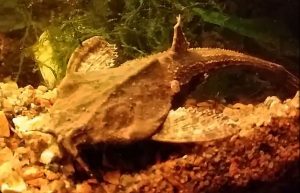The Banjo Catfish (Bunocephalus coracoideus) known to tropical fish keeping enthusiasts as Guitarrita or Bicolor Banjo Catfish is a peaceful species found in the leaf littered creeks and ponds of the Amazon River basin in Brazil, Bolivia, Peru, and Uruguay.
Banjo Catfish (Bunocephalus coracoideus) are nocturnal predators that feed on small worms, crustaceans, debris found among the leafy bottom and occasionally smaller fish. The sandy bottom forest streams, lakes, and ponds that they inhabit are normally littered with fallen leaves, branches, and other debris that they hide among.
Bunocephalus coracoideus is the most common and the largest of the “banjo catfish” species known to tropical fish keeping enthusiasts in dealers tanks however, there are several other undescribed species that occasionally make their way into the aquarium trade.
The Banjo Catfish when viewed from above, is a medium sized catfish with a broad flat head, a long skinny body that resembles the shape of a guitar, and a lumpy looking head; hence it’s native name “Guitarrita“.
The fish is a mottled dark brown to almost black color, which enables it to blend in well with its leafy surroundings on the bottom where they uncannily resemble a dead leaf.
They are not an active species during daylight hours where they often completely bury themselves in the substrate, and even at night they are slow movers. They propel themselves along the bottom in slow jerky movements by taking in water through their mouth and quickly expelling it through their gills. Females are stockier than males, but both sexes have the same camouflage coloration.
The Banjo Catfish is a slow moving, peaceful, secretive species that is compatible with most other peaceful fish of similar size. They usually don’t even try to escape from a net and when released into the tank, they will simply drift down to the bottom.
They make good community tank candidates but should not be kept with smaller fish like neons, small shrimp, or fish fry. In a community tank, they will usually remain hidden during daylight hours and will only appear at night to feed.
Banjo Catfish are best kept in a biotope setup in at least a 20 gallon tank with a soft, sandy substrate covered with rocks, pieces of driftwood, a few large hardy plants, and a layer of dried oak or Indian Almond Leaves
on the bottom for them to hide among. Because of their burrowing activity, they have a tendency to uproot plants. Because they prefer dimly lit conditions, a mat of floating plants
should be considered to diffuse bright overhead lighting and although they are tolerant of a variety of water conditions, a good filtration system is necessary to keep them healthy and happy.
Although Banjo Catfish have been reportedly bred in an aquarium environment, it has rarely been successful. To have the best chance of success, purchase 6 to 8 mature specimens and feed them live foods until females are detected.
Like many catfish, Bunocephalus coracoideus spawn at night and lay their eggs directly onto the substrate. Females guitarrito will lay up to 4,000 eggs into the sandy substrate which will hatch out in around 3 days however, the adults will normally eat their spawn. It’s a good idea to transfer the eggs immediately into a brooding tank with a sponge bubble filter containing the same tank water that the spawn came from until the fry hatch out.
Once the egg sacs are absorbed, the fry can be fed newly hatched brine shrimp or microworms
Banjo Catfish are easy to feed and will eagerly accept live or frozen bloodworms, tubifex, small or chopped earthworms, sinking shrimp pellets
, sinking tablets, and commercially prepared flake foods. Feed them when the lights in the aquarium are turned off in the evening and remove any uneaten food the next morning.
Banjo Catfish are not common but are available from specialty tropical fish keeping shops and online from a variety of dealers, importers, and online catfish forums.
Minimum Tank Size: 20 gallons
Care Level: Easy
Temperament: Peaceful
Aquarium Hardiness: Hardy
Water Conditions: 68-80° F, 2-20 °d, pH 5.8-7.8
Max. Size: 6″
Color Form: Brown, Black
Diet: Omnivore
Compatibility: Community tanks
Origin: South America
Family: Aspredinidae
Life Span: 5 – 12 years
Aquarist Experience Level: Beginner
Family: Aspredinidae




